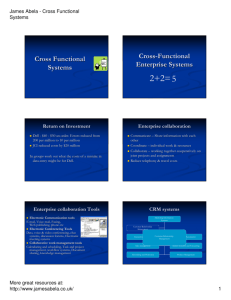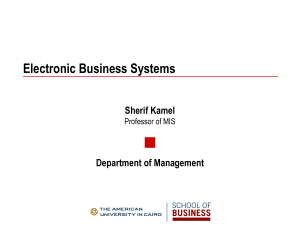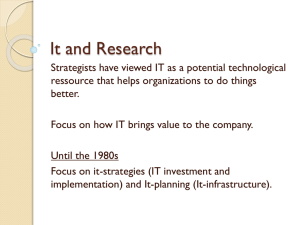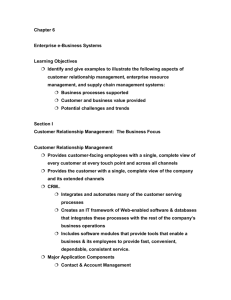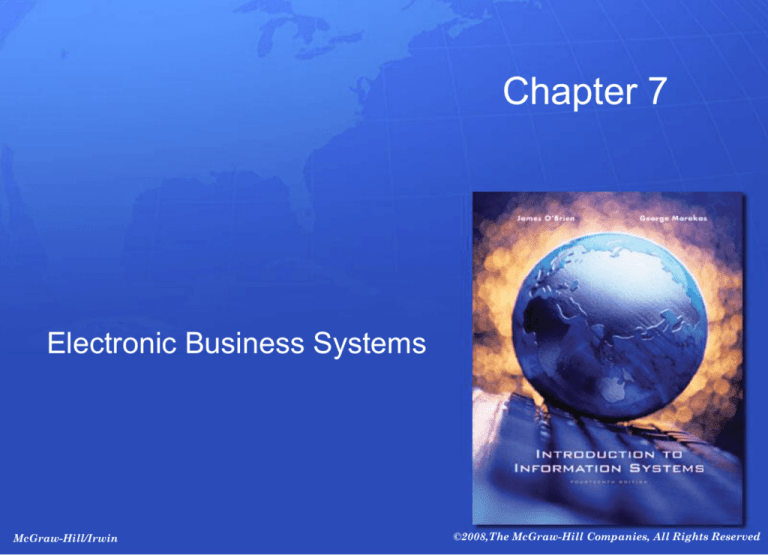
Chapter 7
Electronic Business Systems
McGraw-Hill/Irwin
©2008,The McGraw-Hill Companies, All Rights Reserved
Learning Objectives
1. Identify the following cross-functional
enterprise systems, and give examples of how
they can provide significant business value to a
company:
a.
b.
c.
d.
e.
f.
Enterprise resource planning
Customer relationship management
Supply chain management
Enterprise application integration
Transaction processing systems
Enterprise collaboration systems
7- 2
Learning Objectives
2. Give examples of how Internet and other
information technologies support business
processes within the business functions of
accounting, finance, human resource
management, marketing, and production and
operations management.
3. Understand the need for enterprise application
integration to improve support of business
interactions across multiple e-business
applications.
7- 3
Cross-functional Systems
• Cross the boundaries of traditional business
functions
• In order to reengineer and improve vital business
processes all across the enterprise
7- 4
Enterprise Application Architecture
Source: Adapted from Mohan Sawhney and Jeff Zabin, Seven Steps to Nirvana: Strategic
Insights into e-Business Transformation (New York: McGraw-Hill,2001), p. 175.
7- 5
Customer Relationship Management
(CRM)
• CRM uses technology to
– Create a cross-functional enterprise system
– That integrates and automates many of the processes
in sales, marketing and customer service that interact
with customers
– Create a framework of web-enabled software and
databases that integrate these processes with the rest
of the company’s processes
7- 6
CRM Applications Clusters
7- 7
CRM applications
• Contract and Account Management
– Helps sales, marketing and service professionals
– Capture and track data about past and planned
contacts with customers and prospects
• Sales
– Provides sales reps with software tools and data they
need to support and manage sales activities
– Cross-selling is trying to sell a customer of one product
with a related product
– Up-selling is trying to sell customer a better product
than they are currently seeking
7- 8
CRM applications
• Marketing and Fulfillment
– Help marketing professionals accomplish direct
marketing campaigns by tasks such as
– Qualifying leads for targeted marketing and scheduling
and tracking direct marketing mailings
7- 9
CRM applications
• Customer Service and Support
– Provides sales reps with software tools and database
access to customer database shared by sales and
marketing professions
– Helps create, assign and manage requests for service
– Call center software routes calls to customer support
agents based upon their skills and type of call
– Help desk software provides relevant service data and
suggestions for resolving problems for customer service
reps helping customers with problems
7- 10
CRM applications
• Retention and Loyalty Programs
– Try to help a company identify, reward, and market to
their most loyal and profitable customers
– Data mining tools and analytical software
– Customer data warehouse
7- 11
CRM supports customer life cycle
7- 12
CRM benefits
• Identify and target best customers
• Real-time customization and personalization of
products and services
• Track when a customer contacts a company
• Provide consistent customer experience and
superior service and support
7- 13
Reasons for CRM failures
• Lack of understanding and preparation
• Rely on application to solve a problem without
first changing the business processes
• Business stakeholders not participating and not
prepared
7- 14
Enterprise Resource Planning (ERP)
• Cross-functional enterprise system
– with an integrated suite of software modules
– that support the basic internal business processes of a
company
7- 15
ERP application components
7- 16
Business benefits of ERP
• Quality and efficiency
• Decreased costs
• Decision support
• Enterprise agility
7- 17
Costs of implementing a new ERP
7- 18
Causes of ERP failure
• Underestimating the complexity of planning,
development and training
• Failure to involve affected employees in planning
and development
• Trying to do too much too fast
• Insufficient training in new work tasks
• Failure to do enough data conversion and testing
• Over reliance on ERP vendor or consulting
companies
7- 19
Supply Chain Management (SCM)
• A cross-functional interenterprise system
• To help support and manage the links between a
company’s key business processes
• And those of its suppliers, customers and
business partners
7- 20
SCM goal
• Fast, efficient, low-cost network of business
relationships or supply chain to get a company’s
products from concept to market
• A supply chain:
– Interrelationships with suppliers, customers,
distributors, and other businesses that are needed to
design, build and sell a product
7- 21
SCM
7- 22
Electronic Data Interchange (EDI)
• EDI:
– The electronic exchange of business transactions
– Over the Internet and other networks
– Between supply chain trading partners
7- 23
EDI Examples
7- 24
Role of SCM
7- 25
Goals and Objectives of SCM
7- 26
Causes of problems in SCM
• Lack of proper demand-planning knowledge,
tools and guidelines
• Inaccurate or overoptimistic demand forecasts
• Inaccurate production, inventory, and other data
• Lack of adequate collaboration within the
company and between partners
• SCM software considered immature, incomplete
and hard to implement
7- 27
Enterprise Application Integration
(EAI)
• EAI connects cross-functional systems
• Serves as middleware to
• Provide data conversion
• Communication between systems
• Access to system interfaces
7- 28
How EAI works
7- 29
Enterprise Collaboration Systems
(ECS)
• ECS
– Cross-functional IS that enhance communication,
coordination and collaboration among the members of
business teams and workgroups
7- 30
ECS Goals
• Communicate: share information with each
other
• Coordinate: coordinate individual work efforts
and use of resources with each other
• Collaborate: work together cooperatively on joint
projects and assignments
7- 31
ECS Tools
7- 32
Functional Business Systems
• A variety of information systems (transaction
processing, management information systems,
decision support, etc.)
• That support the business functions of
– Accounting, finance, marketing, operations
management and human resource management
7- 33
Examples of functional information
systems
7- 34
Marketing Information Systems
7- 35
Interactive marketing
• Interactive marketing:
– A customer-focused marketing process
– Using the Internet, intranets, and extranets
– To establish two-transactions
– Between a company and its customers or potential
customers
• Goal:
– to profitably attract and keep customers
– who will become partners with the business
– in creating, purchasing and improving products and
services
7- 36
Targeted Marketing
• An advertising and promotion management
concept that includes five targeting components
7- 37
Targeted Marketing Components
• Community – customize advertising to appeal to people of
specific virtual communities
• Content – advertising placed on a variety of selected
websites aimed at a specific audience
• Context – advertising placed on web pages that are
relevant to the content of a product or service
• Demographic/Psychographic – web marketing efforts
aimed at specific types or classes or people
• Online Behavior – promotion efforts tailored to each visit
to a site by an individual, e.g., using cookies files
7- 38
Sales Force Automation
• Outfit sales force with notebook computers, web
browsers and sales contract management
software
• Connect them to marketing websites and
company intranet
• Goal:
– Increase personal productivity
– Speeds up capture and analysis of sales data from the
field to marketing managers
– Gain strategic advantage
7- 39
Manufacturing Information
Systems
• Support the production/operations function
• Includes all activities concerned with planning
and control of producing goods or services
7- 40
Computer-Integrated Manufacturing
7- 41
CIM Objectives
• Simplify production processes, product designs,
and factory organization as a vital foundation to
automation and integration
• Automate production processes and the
business functions that support them with
computers, machines, and robots
• Integrate all production and support processes
using computer networks, cross-functional
business software, and other information
technologies
7- 42
CIM Systems
• Computer-aided manufacturing (CAM) automate the production process
• Manufacturing execution systems (MES) –
performance monitoring information systems for
factory floor operations
• Process Control – control ongoing physical
processes
• Machine Control – controls the actions of
machines
7- 43
Human Resource Management (HRM)
• Information systems designed to support
– Planning to meet the personnel needs of the business
– Development of employees to their full potential
– Control of all personnel policies and programs
7- 44
HRM Systems
7- 45
HRM and the Internet
• Recruiting employees using the corporate
website and commercial recruiting services
• Posting messages in selected Internet
newsgroups
• Communicating with job applicants via e-mail
7- 46
HRM and Corporate Intranets
• Process common HRM applications
• Allow HRM department to provide around-theclock services
• Disseminate valuable information faster than
through previous company channels
• Collect information from employees online
• Allow managers and other employees to perform
HRM tasks with little intervention by the HRM
department
• Training tool
7- 47
Employee Self-Service (ESS)
• Intranet applications that allow employees to
– View benefits
– Enter travel and expense reports
– Verify employment and salary information
– Update their personal information
– Enter data that has a time constraint to it
7- 48
Accounting Information Systems
• Record and report the flow of funds through an
organization
• Produce financial statements
• Forecasts of future conditions
7- 49
Accounting Information Systems
7- 50
Six essential Accounting
Information Systems
• Order Processing – Captures and processes
customer orders and produces data for inventory
control and accounts receivable
• Inventory Control – Processes data reflecting
changes in inventory and provides shipping and
reorder information
• Accounts Receivable – Records amounts owed
by customers and produces customer invoices,
monthly customer statements, and credit
management reports
7- 51
Six essential Accounting
Information Systems
• Accounts Payable – Records purchases from,
amounts owed to, and payments to suppliers,
and produces cash management reports
• Payroll – Records employee work and
compensation data and produces paychecks and
other payroll documents and reports
• General Ledger – Consolidates data from other
accounting systems and produces the periodic
financial statements and reports of the business
7- 52
Financial Management Systems
• Support business managers and professionals in
decisions concerning
– The financing of a business
– The allocation and control of financial resources within
a business
7- 53
Financial Management System
Examples
7- 54
Case 1: Forex Capital Markets and
Wyse Technology: The Business
Benefits of CRM
• International buying and selling of global currencies is
the largest and most liquid market in the world.
• Microsoft Excel & Access programs could not handle the
increase in business volume and customer information
could not be easily shared.
• FXCM decide to implement CRM software from
Salesforce.com to handle the complexities of their
business.
• CRM software enables sales and marketing
professionals to increase sales revenue by providing
more and better services to customers and prospects.
7- 55
Case Study Questions
1. Why can’t Microsoft Excel spreadsheets and
Access database software handle the
customer relationship needs of companies like
FXCM? What functions do CRM systems like
Salesforce provide to a company that these
software packages do not?
2. What business benefits has the Salesforce
CRM system provided to FXCM? To Wyse
Technology?
7- 56
Case Study Questions
3. Salesforce.com is an example of an ASP
(application service provider), which we
discussed in Chapter 4. What benefits do you
see in this case for that method of providing a
CRM system to a company versus installing a
CRM software package? What disadvantages
might arise? Which method would you prefer?
Why?
7- 57
Real World Internet Activity
1. The success of Salesforce.com hurt traditional
software companies like Siebel Systems, which only
offered CRM as a complex installed software solution.
Siebel, since acquired by Oracle, responded with
Siebel OnDemand, an ASP solution like Salesforce.
Other companies jumped into the CRM/ASP market to
compete with Salesforce.com.
– Use the Internet to research these companies and discover
how Salesforce is responding to this intense competition for
customers in the CRM market.
7- 58
Real World Group Activity
2. The CRM solutions in this case highlight how
much information on customers and prospects
is easily captured, integrated with other
customer data, and accessible to company
employees and even business partners. How
are FXCM and Wyse securing this sensitive
data? Is it enough? What else could be done
to protect customer privacy and security?
– Discuss how companies and their customers can
benefit from CRM systems while still protecting
customer privacy.
7- 59
Case 2: Yahoo, Google, and Chrysler:
How the Internet Is Changing
Advertising and Marketing
• Today companies are spending more money on online
advertising.
• With the increase in online advertising, Yahoo and Google
have become the most highly prized media companies in
the world.
• Yahoo has led the way in persuading large companies to
use online advertising instead of traditional media.
• According to a survey, sixty-three percent said that online
advertising was a brand building tool “equal to or better
than” advertising on TV or in print.
7- 60
Case Study Questions
1. Why are companies like Chrysler now looking
more favorably at the Internet as a great
medium for their advertising dollars? What has
happened to change their view?
2. How do Google’s online ad revenue sources
and strategy differ from Yahoo’s? Which online
ad strategy is superior for attracting advertising
from small companies? For attracting
advertising from large companies? Defend
your position.
7- 61
Case Study Questions
3. If you were director of marketing
communications at Chrysler, how would you
distribute Chrysler’s advertising dollars among
online and traditional TV and print media?
Defend your position.
7- 62
Real World Internet Activity
1. Google and Microsoft’s MSN realize that they
must move beyond search advertising
revenue to block Yahoo’s attempt to dominate
the move of big advertisers to online
advertising. Use the Internet to discover how
the three rivals are faring in the battle for
online advertising and the reasons for any
changes you find.
7- 63
Real World Group Activity
2. Online advertising can be viewed as an
entertainment experience, as a helpful source
of clues to find what you and other customers
want, or as a bothersome intrusion into your
online experience and right to privacy.
–
Discuss this issue. Attempt to formulate a joint
position on these aspects of online advertising to
present to the rest of the class.
7- 64
Case 3: Tesco: Applying Lean Logistics to
Supply Chain Management
• Many companies are using lean logistics management to
save money and Tesco is one example.
• With lean logistics, companies can eliminate waste along
with huge opportunities for savings while increasing the
satisfaction of the end customer.
• At Tesco, with lean logistics system,
– the total throughput time, from the filling line at the supplier to
the customer leaving the store with the cola, has declined
from 20 days to 5 days.
– The number of inventory stocking points has been reduced
from five to two, and
– the supplier’s distribution center for the items has
disappeared.
7- 65
Case Study Questions
1. What key insights of Tesco’s SCM director Graham
Booth helped revolutionize Tesco’s supply chain and
range of retail store formats? Can these insights be
applied to any kind of retail business? Why or why not?
2. How did Dan Jones and his research group from the
Cardiff Business School of Wales demonstrate the
inefficiencies of the Tesco and Britvic supply chains?
Can this methodology be applied to the supply chain of
any kind of business? Why or why not?
7- 66
Case Study Questions
3. What are the major business and competitive
benefits gained by Tesco as the result of its
supply chain initiatives? Can other retail chains
and retail stores achieve some or all of the
same results? Defend your position with
examples of actual retail chains and stores you
know.
7- 67
Real World Internet Activity
1. Use the Internet to investigate Tesco’s present
financial success and competitive position and what
other retailers in Britain are doing to compete with
Tesco. Then investigate if other retail chains or stores
in the United States or any other country seem to be
applying a supply chain management strategy similar
to Tesco’s.
7- 68
Real World Group Activity
2. Many retail chains and stores have loyalty
cards similar to Tesco’s. Use the Internet to
research the loyalty-card performance of these
companies.
– Discuss how these and other retail stores you know
could improve their loyalty-card performance
compared with Tesco’s stellar performance with its
customers.
7- 69




